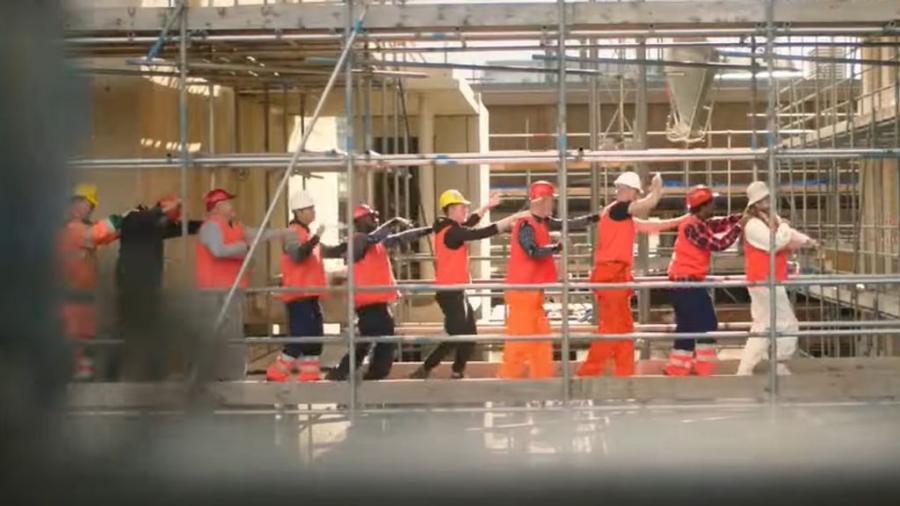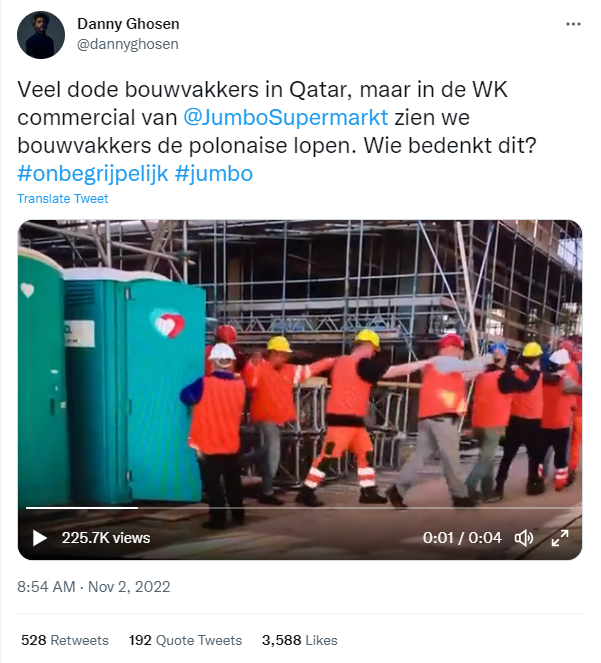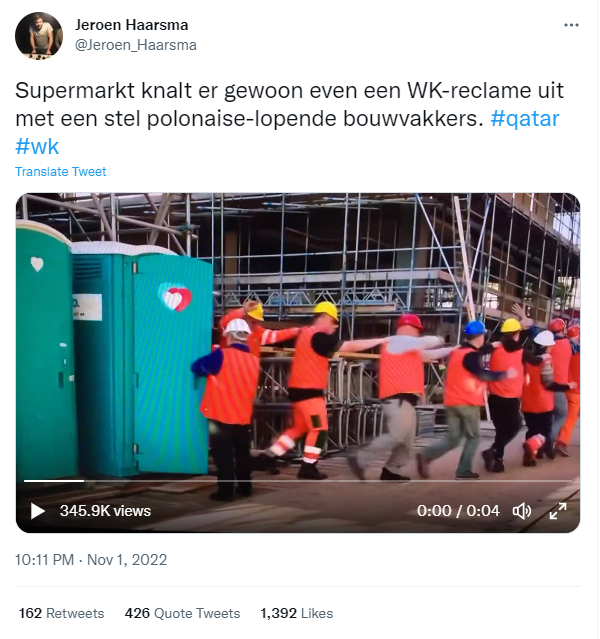
The power of social media in news coverage: Jumbo’s World Cup commercial
The 2022 FIFA World Cup stirred a lot of controversies around the globe. Amidst all these controversies, Dutch supermarket chain Jumbo released an even more controversial commercial. This commercial was quickly picked up by social media, which spiralled into news coverage in mainstream media. This case study analyses how the news coverage of Jumbo's World Cup commercial unfolded, both on social media and in traditional news.
A problematic commercial
On December 2nd, 2010, FIFA president Sepp Blatter announced that the 2022 FIFA World Cup would be hosted by the Middle Eastern country Qatar. The football tournament is generally the most viewed sports event in the world. For the 2022 edition, however, discussions arose on whether to watch the World Cup or not. This is due to several controversies that surrounded Qatar as the host country. One of these controversies concerned Qatar’s labour conditions, which was perhaps the foremost reason people decided not to watch the World Cup in 2022.
The stadiums in Qatar, which were constructed for the occasion, were built on the backs of workers from Asia and Africa. The labour conditions that these migrant workers faced have stirred controversy around the globe. According to Amnesty International (2022), despite Qatar’s attempts to better labour conditions since 2017, these migrant workers still must deal with issues such as delayed or unpaid wages, denial of rest days, hazardous working conditions, and limited access to justice. On top of this, The Guardian revealed that out of the 30,000 labour migrants Qatar hired since 2010, 6,500 had died due to poor labour conditions. Thirty-seven of those deaths have been directly linked to the construction of the World Cup stadiums (Pattison & McIntyre, 2021).
Amidst these unpleasant revelations, Dutch supermarket chain Jumbo released their World Cup commercial for 2022. This commercial, according to many people, completely missed the mark. The commercial advertises for Jumbo’s ‘’Juichvest’’, which roughly translates to ‘’cheering vest’’. This vest can be worn by football supporters while simultaneously functioning as a bag for grocery shopping when you turn the bag inside out. As one might expect, this is not the problematic part of the commercial.
Jumbo's World Cup commercial completely missed the mark.
The commercial shows construction workers wearing the vest while walking in a conga line at a construction site (see Figure 1). This creates an image of festivities and joy, which would normally be an apt image for a World Cup commercial. However, since 2022 World Cup had many negative connotations surrounding labour conditions, Jumbo’s choice of using construction workers to participate in festivities was not their best call.

Figure 1: Screenshot from the Jumbo commercial
This case study analyses Jumbo’s commercial and how it unfolded in the news, both on social media and in traditional news. This paper intends to demonstrate how digital technologies and social media have influenced reports on this issue and to which consequences it has led.
The first signs of citizen journalism
According to Bruns (2017), breaking news become available through social media. In his work Gatewatching and News curation: Journalism, social media, and the public sphere, he demonstrates the dynamics of breaking news on Twitter. He describes that, once a newsworthy event happens, someone with a mobile device and access to the internet will most likely be present, and thus has the possibility to report on the issue online. Therefore, he argues, news break on Twitter. This is also what happened once Jumbo’s commercial aired on Dutch television. Instantly, a lot of people turned to Twitter to share their discontent about the commercial. One of the most prominent figures who posted a tweet was journalist Danny Ghosen (see Figure 2).

Figure 2: ''A lot of deceased construction workers in Qatar, but the WK commercial of @JumboSupermarkt shows construction workers walking in a conga line. Who thinks of this? #incomprehensible #jumbo'' (Own translation)
Ghosen’s tweet got a lot of attention on social media. It is important to note, however, that one of his most recent projects was a documentary on Qatar’s labour conditions called: ‘’In de schaduw van het WK’’ which translates to ‘’In the shadows of the World Cup’’. In this documentary, Ghosen interviewed Nepalese relatives of construction workers who died during the preparations for the 2022 World Cup in Qatar. Therefore, it is evident that, as a journalist, Ghosen has connections to this issue. However, journalists were not the only ones to report on Jumbo’s ‘’big fail’’.
Before Ghosen commented on Jumbo’s commercial on November 2nd 2022, twitter-user Jeroen Haarsma already alerted other Twitter users of this problematic commercial (see Figure 3). Hereby, Haarsma performs a classic act of citizen journalism, a term that captures all the first-person accounts that are generated by ordinary citizens that make a unique contribution to the mainstream media’s news coverage (Allan & Thorsen, 2009).

Figure 3: ''Supermarket just bursts out a World Cup commercial with a bunch of polonaise-walking construction workers. #qatar #wk'' (Own translation)
A hybrid form of news coverage
According to Bruns (2017), these acts of citizen journalism are, in the first place, only visible to the direct followers of the one who performed the act of citizen journalism. However, the affordances of digital media ultimately facilitate a wider spread and reach of these posts. Fundamental functionalities such as liking and sharing are built into the affordances of platforms like Twitter, where these tweets were posted. This resharing and - specifically on Twitter, retweeting – causes much greater visibility online. Both Ghosen’s and Haarsma’s posts have a considerable number of retweets and shares, which also means that both Twitter posts have a substantial amount of visibility in the Dutch online public sphere.
Because of the visibility of these posts on social media, mainstream media quickly picked up on the Jumbo commercial as well. Several mainstream media institutions have commented on the problematic commercial after the first Twitter users commented on the commercial. One of these mainstream media outlets is the Dutch entertainment and news programme RTL Boulevard (see: RTL Boulevard, 2022).
The report on Jumbo’s World Cup commercial thus entails a series of footage and material, contributed by first-hand eyewitnesses or commentators like Haarsma, news organizations and journalists like RTL Boulevard or Ghosen, remote users, authorities, informed participants and many more. This process is what Bruns (2017) calls a ‘’hybrid form of news coverage’’.
Coverage of the issue on social media has caused the mainstream media to quickly pick up on the issue.
Because so many factors contribute to this hybrid coverage, the whole process creates an overload of information and opinions. Therefore, this type of news media coverage can be fairly overwhelming. However, through selective reposting, these heaps of information can be narrowed down. This might sound paradoxical at first, since reposting only generates more online content, but the selective re-sharing of certain posts means that some opinions, voices, or facts are rendered more visible. This process is what Bruns calls ‘’gatewatching’’, which is the key mechanism for collectively highlighting and amplifying those posts that deserve greater attention and reach (Bruns, 2017, p. 84).
Framing Jumbo
Selective reposting processes surrounding the Jumbo commercial mostly concern the two posts already mentioned: namely the post by Danny Ghosen (Figure 2) and Jeroen Haarsma (Figure 3). In the broader online discussion of the commercial, both these posts had significantly higher numbers of retweets and shares than other similar posts. Both these posts share a similar frame. According to Entman (1993, p. 52),
‘’to frame is to select some aspects of a perceived reality and make them more salient in a communicating text, in such a way as to promote a particular problem definition, causal interpretation, moral evaluation, and/or treatment recommendation for the item described.’’
A news frame thus concerns the specific perspective that is adopted while reporting on a news issue.
Ghosen and Haarsma both depict the Jumbo commercial as something negative. They both instantly link the Jumbo commercial to the labour conditions in Qatar. They, therefore, define a particular problem and make a moral evaluation. But not only Ghosen and Haarsma approach the Jumbo commercial in this manner. Other citizens who chose to tweet about the commercial in a similar tone have also gotten some attention on Twitter (see Figure 4).

Figure 4: '’Jumbo dishes The Netherlands justling construction workers in orange outfits dancing the polonaise. The morale in our country has sunk deep. Sponsor or not; #qatar is not a party. Dancing the polonaise on the graves of 6,500 construction worke
The following tweett has received less attention than tweets by Haarsma or Ghosen, but the numbers are significantly high when compared to tweets with a positive approach to the Jumbo commercial (see Figure 5).

Figure 5: ''Fuss, FUSS! There is another thing to whine about! I saw it, shrugged and zapped away. Unfortunately, I didn't film it to show in a vlog or talk show.'' (own translation)
In this tweet, the user clearly states that she finds the commotion surrounding the Jumbo commercial unnecessary. Interestingly, her post did not get much recognition on Twitter, as the uptake shows the post received zero retweets, comments, or likes. This post is, however, only one example of several posts with a positive frame that did not get any attention on social media.
Taken together, this shows how, through selective reposting, certain frames surrounding the Jumbo commercial emerge. Twitter users retweet those tweets that have a negative opinion on the Jumbo commercial, thereby highlighting those opinions on Dutch Twitter. The posts that stress the insignificance of the discussion surrounding the commercial are not given any attention, and therefore do not gain salience in Dutch media.
Coverage in mainstream media
As aforementioned, mainstream media also reported on the Jumbo World Cup commercial. Interestingly, the professional reports in mainstream media adopt similar frames as the citizen reports on social media. For example, on November 2nd, 2022, the Dutch satirical news programme De Avondshow met Arjen Lubach discussed the commercial. In this item, the host of the TV programme (Arjen Lubach) stated:
‘’I have houseplants with a better social antenna (...). It is already dubious that you want to make money from this World Cup, but then you can at least think about it a little bit’’ (author's translation).
In this statement, a clear opinion towards the Jumbo commercial is expressed.
NOS, which is the biggest news organisation in the Netherlands, reported on the commercial as well (see Figure 6).

Figure 6: ''Jumbo flops with World Cup commercial full of partying construction workers'' (own translation)
Stating that the commercial flopped is a highly indicative statement, whereby it becomes clear which position NOS takes towards the Jumbo commercial.
Both examples show that mainstream media adopts similar frames to social media in their reports of the Jumbo commercial. This is most likely because the tweets that were rendered most salient on social media, through reposting, adopted similar negative frames, which ultimately influenced the uptake of the issue by mainstream media.
Incite and influence
Selective reposting on social media highlighted particular frames on the Jumbo commercial in the Dutch public sphere. These frames were then adopted by mainstream media, which, in its totality, snowballed into a mostly negative reportage on the cheerful but problematic Jumbo World Cup commercial. This has ultimately led to the discontinuance of the commercial on Dutch television (see Figure 7).

Figure 7: ''Jumbo has promptly decided to stop the World Cup TV commercial that was available to watch yesterday. We realise that it is possible to make a link to the pitiful labour conditions in Qatar, and that has never been our intention. We would like
Overall, this case study shows how social media has the power to incite interest on a certain issue. The first comments on the Jumbo commercial emerged on Twitter, and only a day later the mainstream media caught up. This fits with Bruns’ (2017) model on the dynamics of breaking news on Twitter, where he states that news first break on Twitter.
Social media has the power to incite and influence news.
Furthermore, Bruns states that social media offers an unprecedented ability for ordinary citizens to influence traditional information flows (Bruns, 2017), which is exactly what happened in the reporting of the Jumbo World Cup commercial. As is shown in this paper, selective reposting made certain frames performed by ordinary citizens on the issue salient, which overflowed into the reporting of this issue in the mainstream media. The totality of these two factors resulted in the discontinuance of the commercial.
This case study proves how social media has the overall ability to provoke and influence news reportage on certain issues. The collaborative gatewatching practices that happen on social media affect how an issue is perceived and managed in the public sphere. In the case of the Jumbo commercial, comments on the commercial emerged on digital platforms like Twitter. These digital technologies and affordances have rendered the issue of public interest and facilitated a negative uptake through selective reposting on social media.
References
Allan, S., & Thorsen, E. (2009). Citizen Journalism: Global Perspectives (Global Crises and the Media) (First printing). Peter Lang Inc., International Academic Publishers.
Amnesty International. (2022, October 20). Qatar: Labour reform unfinished and compensation still owed as World Cup looms. Amnesty International.
Bruns, A. (2017). Gatewatching and News Curation: Journalism, Social Media, and the Public Sphere (Digital Formations) (New). Peter Lang Inc., International Academic Publishers.
De Avondshow met Arjen Lubach, VPRO. (2022, November 2). WK-reclame Jumbo | De Avondshow met Arjen Lubach (S2) [Video]. YouTube.
Entman, R. M. (1993). Framing: Toward Clarification of a Fractured Paradigm. Journal of Communication, 43(4), 51–58.
NOS Jeugdjournaal. (2022, November 2). Jumbo blundert met WK-spotje vol feestende bouwvakkers. Jeugdjournaal.
Pattisson, P., & McIntyre, N. (2022, December 13). Revealed: 6,500 migrant workers have died in Qatar since World Cup awarded. The Guardian.
RTL Boulevard. (2022, November 2). WK-reclame Jumbo met Toppers leidt tot ontsteltenis: “Totaal ongepast.” RTL Boulevard.